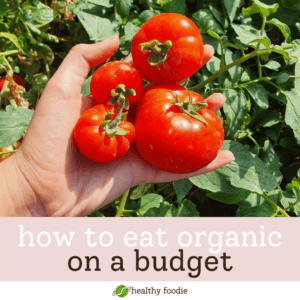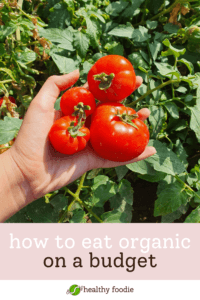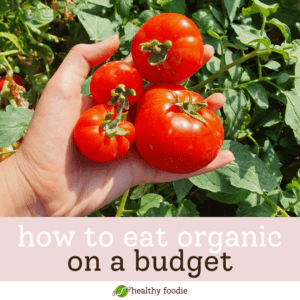
First and foremost, the easiest way to eat organically is to grow your own fruits and vegetables. Simply put, you are able to see exactly what goes into the food you consume. This is the easiest way to regulate pesticides, water, and the food environment. Some of the easiest things to grow if you don’t think you have a green thumb are herbs. They take up very little space in the garden and will save you money since they are expensive in stores. Once you master these tiny plants, move on to larger organic produce like tomatoes, potatoes, and other plants. Read this post to learn How to Grow A Garden! Another great place to start is to buy some organic options that are on the cheaper end of the spectrum. Here is a small list of cheaper organic produce and food items: tea beans corn tortillas potatoes spices apples organic soup organic frozen fruit organic meat chia seeds soy products Many pre-made meals come prepared with tons of preservatives and added unnecessary ingredients that aren’t good for your body. These processed foods may be cheap and ideal while on a tight budget, but they won’t do your health any good. As you are able, cook your meals entirely from scratch. Purchasing all of the ingredients you need to make your meals from scratch is healthier than consuming highly processed foods.

The Environmental Working Group has a list of fifteen fruits and vegetables that are the least pesticide infected. If it is difficult to go completely organic, opt for these options. These fruits and veggies include: sweet corn avocados pineapples frozen peas cabbage onions asparagus papayas mangoes kiwis eggplant cantaloupe grapefruit cauliflower sweet potatoes There are tons of smoothies, shakes, meals, snacks, and breakfast treats you can create using these superfoods. If you aren’t sure what organic food is, read this post about Organic Food to learn more. On the other side, there are some fruits and vegetables that are affected most by pesticides and are a good idea to stay away from unless you buy organic varieties. These include: apples celery strawberries peaches spinach potatoes cherry tomatoes sweet bell peppers grapes nectarines cucumbers snap peas These would be fantastic organic crops to grow on your own if you have the space in your yard. Learn more in my article how to make a clean eating grocery list. An organic produce service won’t necessarily be the cheapest option, but it is definitely convenient. They usually have a wide variety of options and it takes the pressure of going to the grocery store off your plate. They not only offer organic produce but organic livestock as well. Choose from a wide variety of organic meat provided by organic farmers. There are tons of services like this across the globe. Try some of the option mentioned in my Fresh Produce Delivery post. Your local grocery store will offer the most expensive pricing on organic fruits, vegetables, and meat. Your best bet is to head to the local farmer’s market for fresh produce from organic farms. You will be able to compare pricing and check out the healthy food before purchasing. The people selling the food will also be more than happy to share their organic farming practices with you at the stands. It’s a great way to get nutritious foods on the table without breaking the bank. If you shop at big box stores, buy your organic food in bulk whenever you can. Check for organic certification on the food labels of the boxes, cans, and jars. There should be a seal on the food when sold in health food stores. Some of these items may have higher prices, but they will have more health benefits than more processed foods. You will also be avoiding toxic chemicals when you purchase food with a USDA organic seal (United States Department of Agriculture). I personally think it is well worth every penny to purchase organic food. Not only is it good for our planet, but it’s great for our bodies. Organic eating avoids synthetic fertilizers and pesticides and is all around better for the environment. Farmers who grow and sell organic products pay attention to the health of the water, soil, and wildlife they work with. There are TONS of pros to eating organic, but there are a few cons or disadvantages. Here are the few cons associated with organic food: easily goes bad more expensive potentially higher bacteria levels Bottom line, do your research with any food you consume to see if it fits your lifestyle. Starting out, it may take some time to eat completely organic, but over time there are ways. You just have to be smart about your purchases, start your own garden if you have the space, and take the time to do your research. It isn’t unreasonable and is completely sustainable once you find the resources that work for your family. This Clean Eating Blog Post is a great place to start as well. If you are like me and enjoy having a protein shake on hand for a quick meal, there are organic options that taste amazing. Learn about my Favorite Organic Protein Shake here. I hope the simple tips in this blog post about how to eat organic on a budget will help you find organic options while trying to live a healthy lifestyle. When we first started, I thought it would be impossible to find food we could eat, but I was wrong. I was pleasantly surprised at how many options there are to help our family eat organically and choose healthier options for our meals.



